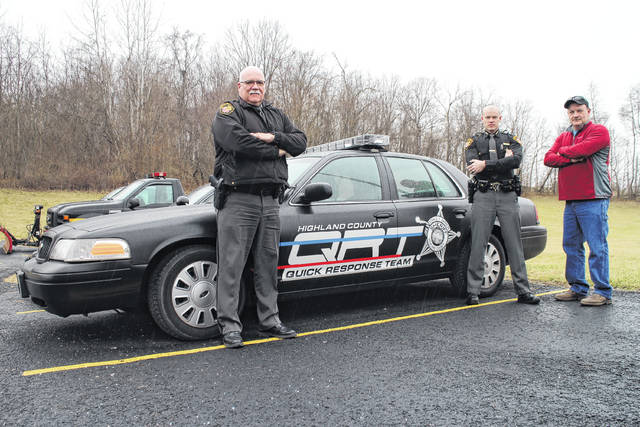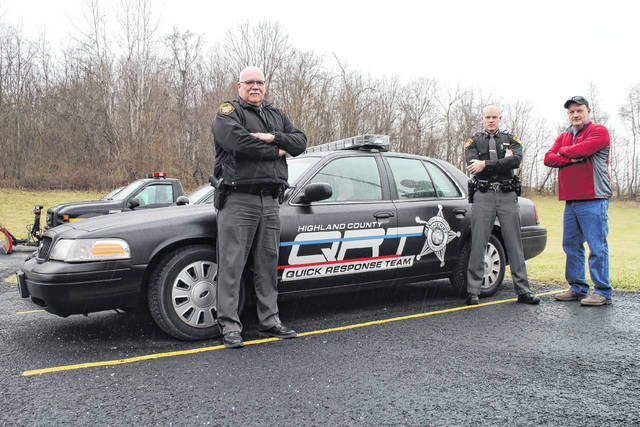



Editor’s note: The following is the third of a three-part series, leading into sustained coverage throughout the year, by The Times-Gazette and the AIM Media Network delving into the impact the opioid epidemic has had on Highland County, across Ohio and the rest of the country.
The newly formed Quick Response Team, a squad of local first responders, medical personnel, health officials and people of faith who will visit the homes of those struggling with drug abuse and offer treatment resources, is set to deploy for the first time next Wednesday in a new set of wheels — the Highland County Sheriff’s Office’s former DARE program cruiser.
Heather Gibson, a local advocate who was instrumental in the formation of the team, said on Thursday that it’s more than an old cop car.
“To me, it’s a sign of hope in our county,” she said. “It’s way more than a cruiser to me.”
Highland County Sheriff Donnie Barrera said the former DARE (Drug Abuse Resistance Education) program cruiser will remain a county vehicle, but will be used by members of the QRT.
Former DARE Officer Bobby Stroop retired from the sheriff’s office last year, and Barrera said the office will install a new one later this year.
Funded by grants from the Ohio Attorney General’s Office and Cincinnati nonprofit Interact For Health, the Quick Response Team concept has been successfully implemented elsewhere.
Barrera said a similar group that deploys in Hamilton County has had a 70-percent success rate — the ultimate goal being connecting those addicted to drugs with the treatment they need.
Initially, Gibson said the Highland County QRT’s mission was to visit the homes of people who overdosed on opioids, but with the use of methamphetamine on the rise, Gibson said the group’s mission had to be expanded.
“It’s not called an ‘opioid response team,’ because we know meth is on the uptick,” she said. “We didn’t want to limit it to heroin or opioids.”
Representatives from the following agencies will deploy with the team on Wednesdays:
• Highland County Sheriff’s Office.
• Highland County Health Department.
• Paint Creek Joint EMS/Fire District.
• Lakehouse Ministries.
• REACH for Tomorrow.
• Scioto Paint Valley Mental Health.
According to Highland County Health Commissioner Jared Warner, who is responsible for keeping track of the group’s data, a number of referrals have already come in.
Gibson said the referrals, which come from law enforcement agencies, fire departments and hospitals, will be used to identify people who need help, and after a briefing at the health department, the team will visit their residence and offer assistance to them.
During visits, medical personnel will conduct assessments to identify the person’s medical problems and treatment needs, and others on the team will provide additional resources, information and emotional support.
Gibson said the team has a contract with Lakeside Ministries, a “stabilization housing” facility in the Rocky Fork Lake area that can hold four women. Women who decide to pursue treatment right away can be transported directly there to wait while the necessary programs are identified.
The group is still working on identifying stabilization housing for men, and in the interim, if a man decides he needs to get into treatment right away, options can be arranged outside the county, according to Gibson.
Warner said the QRT is a worthy investment in the fight against drug abuse here.
“For every dollar that we spend on preventive actions like this, we get a $17 return,” he said. “There’s no better way to spend our time and our money than to go out and work preventively.”
And with rising rates of communicable disease due to used or dirty hypodermic needles being passed around by drug users, Warner said now is the time to act.
“We’ve had a quadrupling, at least, of our Hepatitis C rates in the last five years,” he said. “We’ve got a 40-percent increase in HIV cases in Cincinnati… So we’re seeing real health effects connected to drug abuse… We’re looking out for the health of the population in general.”
Gibson said some of the challenges faced by organizers of the QRT are representative of a larger difficulty in fighting drug abuse in the area.
Mainly, the struggle is identifying resources and pulling them together into cohesive projects, Gibson said, and that’s why the QRT took two years to form.
“Because we’re in a rural area, resources are really limited,” she said. “Getting people to the table and showing the need for them to extend resources is sometimes difficult, because they’re already pulled in so many directions.”
The Highland County Drug Abuse Coalition, of which Gibson is president, began in 2012 as a group of about 10 concerned department heads from different local agencies, but has since grown to upwards of 50 people from a variety of backgrounds dedicated to snuffing out drug abuse here.
And, “as awareness builds, it grows more and more,” said Gibson.
Gibson said as resources are pooled, initiatives like the QRT are made possible, and the community is able to rally behind it.
“(That is) what’s going to solve, and I’m not saying eradicate it, but solve the crisis,” Gibson said.
Reach David Wright at 937-402-2570, or on Twitter @DavidWrighter.



